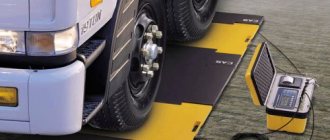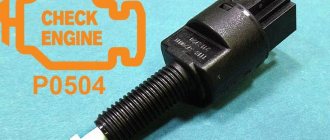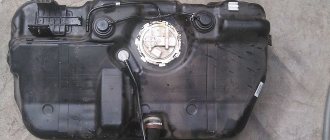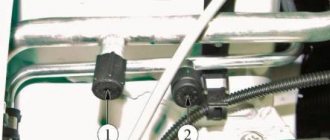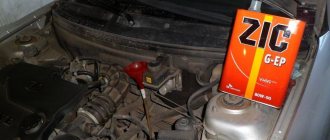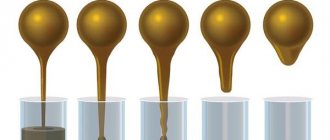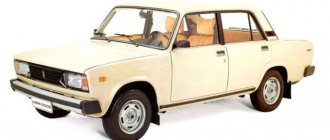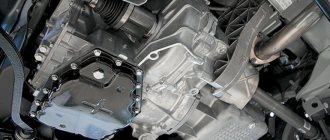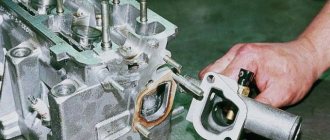What is the service life of the 8-valve VAZ-2114 engine?
Each automobile part has its own power reserve. The VAZ-2114 engine, unlike other elements of the car, can be restored if it has not received a water hammer or damage to the body: both external and internal.
In this article we will talk about the service life of the motor, as well as some nuances of operation and increasing this indicator.
Engine life and operation
VAZ-2114 engine cross-section with description of internal elements
In order not to beat around the bush, let's immediately move on to the issue of engine life.
So, according to the technical documentation, the engine installed on the VAZ-2114 has a travel potential of 150,000 km .
With normal operation and careful handling, the life of this unit can be extended to 200,000 km.
When can we expect a major overhaul?
What's next? - novice motorists may ask themselves a question. Next comes a major overhaul, since the service life of most internal parts has been exhausted. The basics of this operation will be discussed below.
Before considering what will be included in the repair and restoration work on the engine, let’s consider the factors that influence increased wear of the main power unit:
- Driving style . This factor has a primary impact, since frequent engine overloads will lead to increased wear on the internal parts of the power unit. Thus, measured driving can significantly extend the life of this structural element. As practice shows, drivers who drive carefully and carefully are less likely to carry out repairs on car components. Especially those that concern the engine than those that like to drive.
- Timely repair operations . On-line repair is a fairly important factor in the life of the power unit. Thus, valves that are not adjusted in time, or untimely replacement of the cylinder head gasket can significantly reduce the service life.
- Maintenance . Timely maintenance, namely oil changes, can extend engine life. This is due to the fact that the lubricating fluid takes care of all the physical and chemical processes in the engine. The production of one of the parts, namely the metal shavings, will all go into motor oil.
- Quality of spare parts used . Not only the dynamics and power, but also the life of the main power unit depends on what part you install. Thus, a high-quality part has not only greater potential, but also less production, which can end up in the oil in the form of residues.
16-valve VAZ-2114 engine
Now that we have considered the main reasons that affect the engine’s performance potential, we can also consider the basic concepts that will be included in the overhaul of the power unit after the end of its service life:
- Grinding the crankshaft to repair dimensions for main and connecting rod bearings.
- Boring and honing of the cylinder block.
- Installing a new piston according to the block bore size.
- Replacing a set of motor gaskets.
- Repair or replacement of the oil pump.
- Replacement of valves and guide bushings.
- Replacing the camshaft.
- Replacement of the water pump and other elements of the cooling system.
- Grinding the surface of the block and cylinder head. and motor oil.
- Restoration work. For example, argon welding of the block head in places where cracks form.
- Other work aimed at restoring engine life.
As practice shows, after a major overhaul of the engine, the service life of the power unit is reduced. Typically this figure is 120-130 thousand kilometers.
Increase in resource
Increasing the service life of the main power unit is an issue that many experienced motorists are struggling with. This is due to the fact that foreign analogues of the VAZ-2114 have a real engine potential of 250,000 km and above . Therefore, every owner of this car wonders how to increase the life of the engine.
Physically, this is practically impossible to do, except for the option of replacing most of the parts with sports ones, which are superior in quality to standard spare parts.
But this option may not be suitable for everyone, since the price of such an upgrade is too high.
There is a second option, which does not require investment, and will also extend the life of not only the engine, but also other parts of the car. So, let's consider the conditions under which the engine life can be increased to 250,000 km:
- Careful operation.
- Timely on-line repairs.
- Routine maintenance in accordance with all rules.
- Do not overload the engine. Jerks and other loads negatively affect internal parts.
- Avoid catastrophic consequences of malfunctions, such as overheating.
- Installation of only high-quality spare parts.
conclusions
As can be seen from the article, the service life of the VAZ-2114 engine largely depends on the owner of the car. The manufacturer set the average potential of the engine, which is designed for 150 thousand kilometers. But every motorist, following the operating rules and taking care of his vehicle, can extend the life of the main power unit to 250,000 km.
Unqualified maintenance
Insufficient quality of air purification, or, even worse, a break in the air filter curtain will reduce the service life of the motor significantly. A heavily clogged filter will not let dirt through, but neither will air. The motor will operate in an off-design mode, and this will not extend its life.
The piston skirt and rings are covered with deep scratches - the engine clearly ran on a sand-air mixture.
The piston skirt and rings are covered with deep scratches - the engine clearly ran on a sand-air mixture.
It is important to follow the replacement intervals prescribed in the instructions. More frequent replacement is needed only in steppes and semi-deserts with their eternal dust. I advise you not to buy the cheapest filters - they can let large particles through. A good thing cannot be too cheap. It is best to buy filters from online spare parts stores.
Maximum mileage of a VAZ engine before major overhaul
It has long been known that each internal combustion engine has its own “safety margin”. It is also no secret that foreign car engines have a longer service life than products of the domestic automobile industry. This is due to the better quality of parts, more modern technologies in their manufacture, as well as the accuracy of assembly and tuning of the internal combustion engine.
Possible faults
The VAZ-2115 engine has several typical problems that you need to be able to diagnose correctly:
- A knocking sound in the power plant under load may be caused by the need to adjust the valve clearance.
- At idle the speed fluctuates and fluctuates. In this case, it is necessary to conduct a thorough diagnosis, after which, most likely, the idle air control valve or throttle sensor will have to be replaced.
- Difficulties in starting the engine, its operation with popping noises and strong vibrations are most often caused by a failure of the injection system. The situation can be corrected by cleaning the injectors and checking their functionality.
- The need to warm up the engine for a long time is necessary when the thermostat fails. With this malfunction, the fluid circulation in the large circuit is closed. In some cases, the motor does not reach operating temperature at all. After replacing the thermostat, engine operation is restored.
In case of any of the described malfunctions, it is necessary to conduct a thorough diagnosis. Only after this can repairs begin.
Engine for VAZ 2114, characteristics, repair and tuning
In 2001, the VAZ line of cars was replenished with a five-door hatchback, popularly called the “four”. The VAZ 2114 engine was repeatedly modified and improved.
In different years of production, the car was equipped with eight-valve engines of 1.5 liters and 1.6 liters.
Also, sixteen-valve internal combustion engines with a volume of 1.6 liters were installed on the cars. The model was produced until 2013.
Specifications
1.5l
The main difference between the VAZ 2114 engine and the 21083 engine, on the basis of which it was developed, was the use of an injection system instead of an obsolete carburetor and camshaft with modified phases. The connecting rods are attached to the pistons using a floating pin.
| Parameter | Meaning |
| Put into production | 1994 |
| Configuration | L4 |
| Volume, l | 1499 cm3 |
| Number of valves per cylinder | 2 |
| Piston stroke | 71 mm |
| Cylinder diameter | 82 mm |
| Compression ratio | 9.8 |
| Gas distribution mechanism | OHV |
| Rated power | 78 l. With. at 5400 rpm min. |
| Max. torque | 116 Nm at 3 thousand rpm. min. |
| Supply system | Injector |
| Fuel | AI 93 |
| Claimed gas mileage | 7.3 l/100 km combined cycle |
Installed on VAZ 2115, 21083, 21102, 21099, 21122, 2111, 2113, 21102, 21093.
1.6l
Thanks to the increase in height of the cylinder block (2.3 mm), it was possible to increase the piston stroke and engine volume to 1.6 liters. The designers have achieved greater throttle response and improved environmental performance of the VAZ 2114 engine.
The car received an increase in power (81 hp and 125 Nm of torque), but lost in efficiency. Now the consumption of AI 95 in the combined cycle is 7.6 l/100 km.
| OPTIONS | MEANING |
| Put into production | 2004 |
| Configuration | L4 |
| Volume, l | 1596 cm3 |
| Number of valves per cylinder | 2 |
| Piston stroke | 75.6 mm |
| Cylinder diameter | 82 mm |
| Gas distribution mechanism | OHV |
| Rated power | 81 l. With. at 5200 rpm min. |
| Max. torque | 125 Nm at 3 thousand rpm. min. |
| Supply system | Injector |
| Fuel | AI 95 |
| Claimed gas mileage | 7.6 l/100 km combined cycle |
| Parameter | Meaning |
| Put into production | 2004 |
| Configuration | L4 |
| Volume, l | 1596 cm3 |
| Piston stroke | 75.6 mm |
| Compression ratio | 9.6 |
The 1.6i engine was equipped with: VAZ 21112, 21101, 21121, 2113, 2115, Lada Granta and Lada Kalina.
16V 1.6i l VAZ 211440-24
The logical development of the Kalina engine was a sixteen-valve engine. VAZ 2114, equipped with a 124 engine, meets Euro-3 environmental requirements.
The piston stroke and cylinder diameter remained the same. Thanks to minor modifications, at 5 thousand rpm the engine develops maximum power of 89 hp. With. Consumption in the combined cycle was reduced to 7.5 liters. per hundred.
| OPTIONS | MEANING |
| Put into production | 2004 |
| Configuration | L4 |
| Volume, l | 1599 cm3 |
| Number of valves per cylinder | 4 |
| Piston stroke | 75.6 mm |
| Cylinder diameter | 82 mm |
| Compression ratio | 10-Mar |
| Gas distribution mechanism | OHV |
| Rated power, l. With. at 5 thousand rpm. | 89 |
| Max. torque, Nm at 3700 rpm. | 131 |
| Supply system | Injector |
| Fuel | AI 95 |
| Claimed gasoline consumption, l/100 km combined cycle | 7.5 |
16V 1.6i (124) was also installed on the models: VAZ 21124, 21123 Coupe, 21104, 21114.
16V 1.6i l VAZ 211440-26
ICE 21126, also known as the Priora engine, received a number of significant improvements:
- Federal Mogul lightweight connecting rod and piston group (39%);
- smaller valve wells;
- modified timing drive with automatic tension;
- better cylinder honing;
Thanks to these changes, the engine received an increase of 9 liters. With. and a peak torque of 145 Nm. In the combined cycle, the “four” with a 126 engine consumes 7.2/100 km.
| OPTIONS | MEANING |
| Put into production | 2007 |
| Configuration | L4 |
| Volume, l | 1597 cm3 |
| Number of valves per cylinder | 4 |
| Piston stroke | 75.6 mm |
| Cylinder diameter | 82 mm |
| Compression ratio | 11 |
| Gas distribution mechanism | OHV |
| Rated power | 98 l. With. at 5600 rpm min. |
| Maximum torque | 145 Nm at 4 thousand rpm. min. |
| Supply system | injector |
| Fuel | AI 95 |
| Claimed gas mileage | 7.2 l/100 km combined cycle |
16V 1.6i (126) is also received by the Lada family (Priora, Kalina, Granta, Kalina of the second generation).
Design
All modifications of the engine installed on the VAZ 2114 have a block cast from cast iron and a fuel injection system. Despite the design solutions used to improve dynamic and environmental performance, the design of the VAZ 2114 engine has retained its simplicity and reasonable maintenance cost.
Operation and resource availability
An oil change should be done every 9-11 thousand km.
Regardless of the modification, 3.2 liters will be required to change the oil. Recommended viscosity: 5W-30, 10W-40, 5W-40, 15W-40. According to the manufacturer, the engine life is 150 thousand km. (200 thousand km for Priora motor). Practice has shown that with proper maintenance, the engine can cover up to 250 thousand km.
Failure to comply with maintenance standards and improper tuning of the VAZ 2114 engine significantly reduces its service life.
Features and Disadvantages
- after a timing belt breaks, the valves remain unharmed;
- Regular adjustment of valve clearances is required;
- wear of cooling system components;
- oil leaks from under the valve cover;
- oil leakage from under the ignition distributor and fuel pump;
- poor fastening of the exhaust manifold (solved by replacing steel nuts with brass ones);
- unreliability of early injection systems.
- A broken timing belt does not deform the valve;
- the need for periodic valve adjustment;
- increased noise and vibration load.
- Thanks to the holes on the pistons, even with moderate sports shafts, if the timing belt breaks, the valves do not bend;
- Every 15 thousand km you need to tighten the timing belt.
- a broken timing belt leads to bending of the valves (the problem can be solved by installing plug-free pistons.
Popular faults
Due to the imperfect quality of the unit and the large number of low-quality spare parts, the motor and attachments require increased attention.
Main problems and possible causes:
- Unstable idling of the VAZ 2114, the engine stalls after starting. Cause – Coking of the idle speed controller (IAC), throttle position sensor, vacuum seal “drizzle”, unreliable signals from the mass air flow sensor;
- Starting has deteriorated, the engine is running rough - the reason may be: incorrect valve adjustment, lack of compression in one of the cylinders (the valve may have burned out), wear of the valve springs, air leaks (check the connections of the hoses and pipes going after the mass air flow sensor and to the vacuum valve, valve hose purging of the absorber, tight fit of the injectors to the cylinder head), malfunction of the ignition module, spark plugs do not produce a spark, inoperability of high-voltage wires, incorrect valve timing (the timing belt may have slipped a few teeth);
- The VAZ 2114 engine has lost throttle response and does not pull. The breakdown is possible due to a malfunction of the ignition module (symptoms appear when the engine is warm), a clogged catalyst, the fuel pump does not create the required pressure, a dirty air filter, air leaks, carbon deposits on the spark plugs, lack of compression;
- Extraneous knocking, noise and vibration of the VAZ 2114 engine. Failure may occur because valve clearances need adjustment, sagging valve springs, sagging seats, wear on the main bearings of the crankshaft or connecting rod bearings (it is possible that the pistons themselves are knocking), hydraulic compensators, wear on the engine mounts (pillows);
- Does not show the engine temperature of the VAZ 2114. Occurs due to a malfunction of the coolant temperature sensor (the sensor screwed into the cylinder head is responsible for the readings on the instrument panel), open circuit, oxidation of contacts, a malfunction in the indicator on the dashboard;
- The engine is heating up. Thermostat failure (liquid circulates only in the engine cooling jacket). When buying a thermostat, look in the instructions for what engine operating temperature it is designed for (for the engines in question this is 95-103 degrees); Damage to the water pump impeller, malfunction of the fan switch sensor, or the fan itself does not work.
Improving dynamic characteristics (tuning)
For many owners, the standard dynamics of the VAZ 2114 are not enough. Engine tuning allows you to improve the dynamics and customize the character of the car.
As practice has shown, chip tuning of VAZ 2114 engines does not lead to tangible improvements.
Let's look at more serious improvements:
- For owners of eight-valve engines, the easiest way to improve dynamics is to install a cylinder head from a 16-valve engine. Modification of the 1.5l block is also possible.
- The easiest way to tune a VAZ 2114 engine is to install camshafts different from stock. For example, OKB Dynamics 108 will give an increase in the highs without a noticeable loss in the lows.
- By supplementing the shaft with a sliding timing gear and a suitable phase setting, you can get + 7 hp. With.
- Installing an enlarged throttle valve (54 mm), a receiver and a 4.2.1 spider will improve cylinder purging and give noticeable changes during acceleration (the level is close to Priora).
- A modified cylinder head, lightweight valves and a modified intake manifold paired with an increase in engine volume to 1.6 liters will allow you to achieve a power of 110 hp. With. Tuning up to 120 horsepower will take place without loss of resource.
The principle of improving the power characteristics of sixteen-valve engines is similar to the process of refining V8 1.5i l and V8 1.6i l. More evil camshafts, direct-flow exhaust, a receiver, an enlarged damper, a lightweight Priorov piston group, in the case of the Kalina engine (124) and proper tuning will give a significant increase in dynamics.
Regardless of the number of valves per cylinder, the power of the VAZ 2114 engine can be significantly increased by installing a compressor or turbocharging. Engines modified in this way easily reach 170–190 hp. With.
There are many different configurations and options for improving the vehicle's dynamic performance. You can decide for yourself how to increase the power of the VAZ 2114 engine. Remember that the selection of mechanical modifications and software must match each other.
Where and from whom can I order the service?
If an engine overhaul of a VAZ-2114 is required, then there are several options:
- Take the car to a car service center.
- Contact a private master.
- Repair the unit yourself.
A major type of repair requires extensive knowledge, skills, experience, certain equipment and tools. Therefore, only a master of a service center can carry out a high-quality engine restoration. Car service centers issue a warranty certificate. You should contact private traders only on the advice of good friends. Among such workers there are often low-skilled people. In addition, they do not provide a warranty card.
On cars of the Samara 2 series, the Volzhsky Automobile Plant installed injection engines with electronic, distributed fuel injection. And for the VAZ 2114, which appeared in 2001, and was launched into series in 2003, such a power plant was developed - model 2111. In subsequent years, various modifications of this car were produced and some of them were equipped with other engine models, such as - 21114, 11183, 21124 and 21126. But the most popular production cars were the VAZ 2114 with engines of models 2111 and 11183.
VAZ 2114 engine: characteristics
The VAZ 2114 injector engine is a series of engines that were installed on the Lada 2114 vehicle. Like many Lada models, the 2114 model received several power unit options over all years of production. So, the technical characteristics of each of them were different. Let's consider the design of the 2114 engine, as well as issues of maintenance, tuning and repair.
Specifications
VAZ 2114 car
The technical characteristics of the VAZ 2114 engine are quite typical for the 2113-2115 series of cars. In addition, this power unit is developed on the basis of the “eight” engine, which has declared itself to be reliable and easy to repair. The car was produced from 2001 to 2013. During this period, the vehicle received five valuable power units.
VAZ 2114 engine structure
As was said earlier, the 2114 was equipped with five different power units, which differed in power and valve mechanism. Three of them had 8 valves, and the other two had 16. The gas distribution mechanism had a belt drive. Until 2007, the engine was equipped with a simple on-board computer, which did not regulate the operation of the engine based on sensor readings. Therefore, the motorist had to regulate the processes the old fashioned way, manually. Since 2007, an ECU was installed, which, receiving data from sensors, independently adjusted many processes.
Design features of the engine.
Since the second generation had a so-called two-way electronic engine control unit, it is worth considering what electrical circuit was installed.
Electrical diagram of a VAZ 2114 car.
Main characteristics of the motor
All engines that were installed on the vehicle had approximately the same characteristics and design features. So, the motor is easy to service and repair with your own hands. Let's look at the main technical characteristics of the VAZ 2114 engine:
VAZ 2111
| Name | Index |
| Volume | 1.5 liter (1499 cm3) |
| Number of cylinders | 4 |
| Number of valves | 8 |
| Fuel | Petrol |
| Injection system | Injector |
| Power | 77 hp |
| Fuel consumption | 8.2 l/100 km |
| Cylinder diameter | 82 mm |
VAZ 21114
| Name | Index |
| Volume | 1.6 liter (1596 cc) |
| Number of cylinders | 4 |
| Number of valves | 8 |
| Fuel | Petrol |
| Injection system | Injector |
| Power | 81.6 hp |
| Fuel consumption | 7.6 l/100 km |
| Cylinder diameter | 82 mm |
VAZ 11183
| Name | Index |
| Brand | 11183 |
| Marking | 1.6 8V |
| Type | Injector |
| Fuel | Petrol |
| Valve mechanism | 8 valve |
| Number of cylinders | 4 |
| Fuel consumption | 9.6 liters |
| Piston diameter | 82 mm |
| Resource | 200 – 250 thousand km |
VAZ 21124
| Name | Index |
| Volume | 1.6 liter (1599 cc) |
| Number of cylinders | 4 |
| Number of valves | 16 |
| Fuel | Petrol |
| Injection system | Injector |
| Power | 89.1 hp |
| Fuel consumption | 7.0 l/100 km |
| Cylinder diameter | 82 mm |
VAZ 21126
| Name | Index |
| Volume | 1.6 liter (1597 cc) |
| Number of cylinders | 4 |
| Number of valves | 16 |
| Fuel | Petrol |
| Injection system | Injector |
| Power | 97.9 hp |
| Fuel consumption | 7.2 l/100 km |
| Cylinder diameter | 82 mm |
Engine VAZ 2114.
All engines were equipped with 5-speed manual transmissions. Engine volume ranges from 1.5 to 1.6 liters. This car was not equipped with a large power unit. The average engine power of the VAZ 2114 is 85 horsepower.
Motor maintenance
When the design and main technical characteristics inherent in the VAZ 2114 engine have been reviewed, it is necessary to consider maintenance and provide answers to questions that motorists are increasingly asking.
Maintenance
If you believe the plant, the manufacturer, the VAZ 2114 engine must be serviced every 12-15 thousand kilometers. It depends on what marking the motor is installed on the vehicle. Maintenance scheme for all engines installed on the “fourteenth” model:
- At the first maintenance, the oil, oil filter and air filter element are replaced, as well as the functionality of all systems is checked.
- The second maintenance is done after 12,000 km. In this case, it is necessary to change the oil and oil filter element.
- Third maintenance – 25,000 km, replacing not only the oil, but also the air filter, and ongoing repair of faults.
- After 45,000 km, it is necessary to replace the timing belt and roller so that the VAZ 2114 engine does not have to be overhauled.
Subsequent maintenance is carried out in accordance with 2 and 3 maintenance.
Frequently asked questions and their answers
The process of repairing a VAZ 2114 engine.
Many car enthusiasts on forums ask the same questions. Let's try to classify all of them, and also give answers according to factory standards and recommendations.
What kind of oil should be poured into the VAZ 2114 engine?
If you rely on the manufacturer’s data, then different oil is poured into the VAZ 2114 engine, depending on the type. So, what kind of oil should you put in the VAZ 2114? If you take it for an 8 valve engine, then ideally it would be suitable with the 10W-40 marking. If it is a 16 valve engine - 5W-30. In any case, the oil for the VAZ 2114 should be semi-synthetic.
What is the operating temperature of the engine?
Based on the manufacturer's data, the operating temperature of the motor for engines installed on models 2113-2115 is 87-103 degrees Celsius. After 105 degrees the electric fan turns on.
Where is the engine number on the VAZ 2114?
The engine number is quite easy to find. It is located on the gearbox side, near the thermostat. The engine number always has a pad on the cylinder block, which is located in a visible place.
What is the resource of ICE 2114?
The service life of the VAZ 2114 engine is 150 thousand km for an eight-valve power unit and 180,000 km for a 16-valve power unit. To extend the service life, you need to know what oil to pour into the engine, as well as service it on time. Although driving style and careful operation of the car play an important role.
Do valves bend on VAZ 2114 engines?
Of course, like in any other engine, the VAZ 2114 has a valve mechanism that bends. This often happens due to overheating, when the head bends. The valves can also bend if the timing belt breaks.
What to do if the engine does not develop power and the speed drops?
In this case, it is worth carrying out a comprehensive diagnosis of the power unit. The issue may lie either in the inoperability of one of the sensors or in the mechanics. You can find the fault on your own or with the help of professionals at a car service center.
Typical breakdowns
The very first 1.5 liter engine 2114 has disadvantages:
- periodic valve adjustment;
- unreliable injection system;
- loosening the exhaust manifold nuts;
- Leaking gaskets of the fuel pump, distribution sensor of the ignition system.
The next 1.6 liter engine does not cause any particular problems for the owner, with the exception of high vibration and noise loads. The weak point traditionally remains the valves, which have to be constantly adjusted.
The internal combustion engine from Lada Kalina 11183 was installed on the fourteenth model solely to meet Euro-3 standards. It has typical disadvantages for a linear series and is no different.
The first sixteen-valve engine 21124 does not bend the valves, the gaps in which are adjusted by hydraulic pushers. However, the belt needs to be tightened after 15,000 km due to the large number of attachments. The second and last in the line of fourteenth ICE models, ICE 21126, has increased power. In addition to typical malfunctions, if the timing belt breaks, the piston will bend the valve due to insufficient recess depth.
Possible faults
The VAZ-2115 engine has several typical problems that you need to be able to diagnose correctly:
- A knocking sound in the power plant under load may be caused by the need to adjust the valve clearance.
- At idle the speed fluctuates and fluctuates. In this case, it is necessary to conduct a thorough diagnosis, after which, most likely, the idle air control valve or throttle sensor will have to be replaced.
- Difficulties in starting the engine, its operation with popping noises and strong vibrations are most often caused by a failure of the injection system. The situation can be corrected by cleaning the injectors and checking their functionality.
- The need to warm up the engine for a long time is necessary when the thermostat fails. With this malfunction, the fluid circulation in the large circuit is closed. In some cases, the motor does not reach operating temperature at all. After replacing the thermostat, engine operation is restored.
In case of any of the described malfunctions, it is necessary to conduct a thorough diagnosis. Only after this can repairs begin.
Approximate price
On average, a major overhaul of a VAZ-2114 engine costs from 22,000 rubles. Engine repair cost broken down:
- Dismantling – 500 rubles.
- Installation – 600 rubles.
- Replacing oil scraper caps – 2000-4000 rubles.
- Pulling the engine sump - about 490 rubles.
- Crankshaft grinding – from 900 rubles.
- Replacing a crankshaft bearing costs about 330 rubles.
- Honing and boring on a standard block – from 1000 rubles.
- Replacing the valve cover – 420-620 rubles.
- Replacement of the engine mount – from 540 rubles.
Replacing the engine on a VAZ-2114 will cost approximately 5,500 rubles. This does not include the price of a new unit.
